A Green New Deal offers a blueprint for a rapid transition to a sustainable economy that brings everyone along, delivering more prosperity to Canadians and guaranteeing that no workers will be left behind in the transition.
By Ryan McGreal
Published May 10, 2019
Here is a chart of annual per-capita greenhouse gas (GHG) emissions (in tonnes of carbon equivalent) 1990-2013 for Canada and selected other countries with high quality of life.
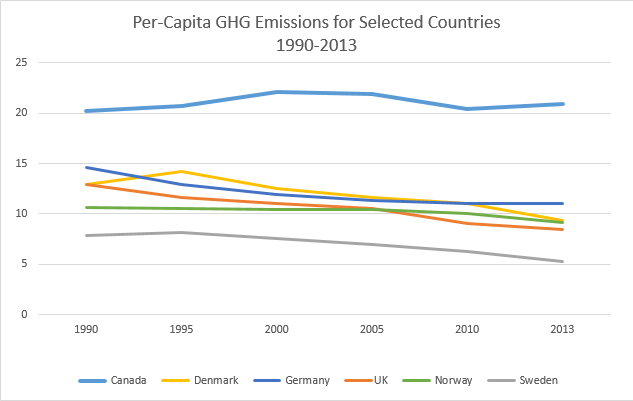
Chart: Per-Capita GHG emissions (tonnes of CO2 equivalent) for Selected Countries, 1990-2013
You will notice that Canada, the thick blue line at the top of the chart, has by far the highest per capita emissions and failed to reduce those emissions during that period.
The other selected countries all started with significantly lower per-capita emissions than Canada and reduced this emissions still further during the same period.
Every country is different, and there are a variety of different ways to reduce GHG emissions. Indeed, the selected countries have each taken their own approach. There is always room for improvement, but these countries are demonstrating what is possible with a combination of policy and investment.
However, the most important first step is to agree to do something to reduce emissions, instead of endlessly fighting over which policy to adopt, or even whether it is necessary to do anything at all.
In Denmark, the focus has been on winding down their use of oil and coal for electricity, phasing out the sale of new diesel- and gas-powered cars by 2030, and achieving 100 percent renewable power by 2035. There are large tax incentives to buy electric vehicles, and all new public transit vehicles will have to be carbon-neutral by 2020.
Denmark is also positioning itself to be a global exporter of clean-air technology for buildings, and there is a push toward "precision farming" to reduce agricultural emissions.
On a refreshing note, climate policy is not a partisan issue in Denmark - every party across the spectrum is united in supporting the national climate plan.
In Germany, the focus has mainly been on investing heavily in transitioning entirely to rewewable electricity. As a result of Germany's Energiewende policy, renewables now produce 40 percent of Germany's electricity.
However, the goal of reducing emissions was complicated by the decision to shut down Germany's nuclear power plants after the 2011 Fukushima Daiichi nuclear disaster in Japan, as it has required Germany to increase its interim use of coal power. From a climate perspective, it would have been better to phase out coal first.
Still, Germany committed earlier this year to shut down coal plants with a capacity over 12.5 gigawatts (GW) by 2022 and phase out all coal power by 2035.
In the United Kingdom, emissions have been falling steadily for the past half-century after a peak in the early 1970s. In 2008, the country passed a Climate Act that legally binds the Secretary of State to achieve reduction targets and empowers an independent Committee on Climate Change to advise the government on how best to meet its targets.
Last week, the British Parliament made history by being the first national government on earth to declare a climate emergency. (The government of Ireland followed suit a week later.)
Norway has pledged to become carbon-neutral by 2030 and is rapidly phasing out fossil fuels across the entire economy (electricity generation is already almost entirely renewable).
A big part of that country's push has been strong incentives to buy electric cars. Just last month in April, Norway made history when electric cars made up 58.4 percent of total new car sales. They may actually exceed their goal of eliminating the sale of new diesel- and gas-powered cars by 2025.
The geometric curve of electric car sales in Norway shows how quickly a new technology can cross a tipping point once incentives are in place to foster the transition.
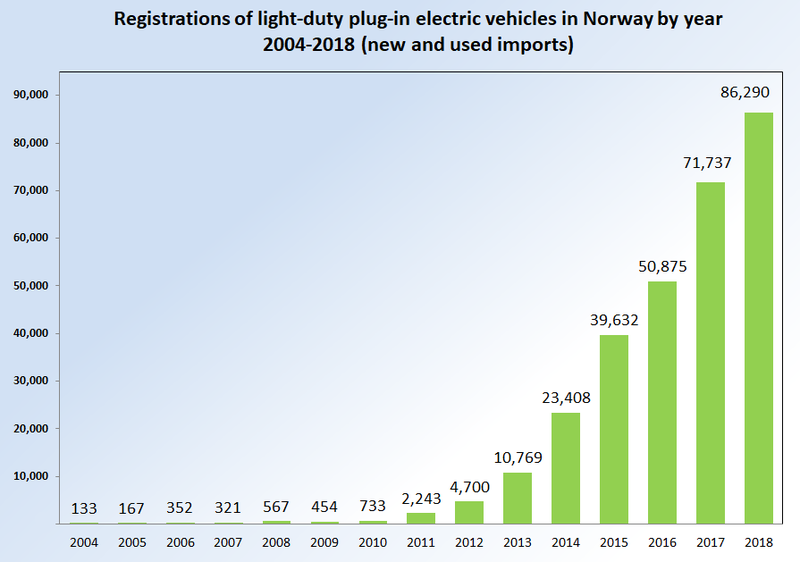
Chart: registrations of new electric cars in Norway, 2004-2018 (Image Credit: Mario Roberto Durán Ortiz/Wikipedia, licenced under CC BY-SA 3.0)
Sweden adopted a carbon tax way back in 1991, soon after the world first learned about the challenge of global warming. The cost per tonne has increased steadily since then and now stands at around $160 CDN per tonne. During this period, the Swedish economy grew by 60 percent while emissions fell by 25 percent.
Carbon emissions are a market externality - a cost of a market transaction that neither the buyer nor the seller has to pay, and which must be borne by society as a whole.
Putting a price on carbon shifts some of the monetary responsibility back to the buyer and seller, and that price signal creates an incentive for people to find alternate, less-polluting ways to do business.
In Canada, 40 percent of our GHG emissions come from industry. Another 25 percent come from transportation, 13 percent come from forestry, agriculture and waste, 11 percent come from buildings, and 11 percent come from electricity generation.
Prior to April 1, 2019, Canada had effectively no national climate policy. Under the new Pan-Canadian Framework on Clean Growth and Climate Change, every province is required to have a provincial policy to put a price on carbon. Provinces that refuse to adopt their own carbon pricing system are subject to a national carbon tax backstop - a $20/tonne tax on carbon emissions.
This tax is revenue-neutral: the money collected is being returned to Canadians in a "Climate Action Incentive Payment" paid through income tax returns. In a politically smart move, the first incentive payment is being paid with this year's income tax returns, at the start of the period in which the carbon tax is being collected. (Sidenote: Jen Dawson suggests 16 ways to spend your carbon tax dividend.)
So far, four Canadian provinces - all of them led by Conservative governments - have refused to adopt a provincial carbon pricing system: Manitoba, New Brunswick, Ontario and Saskatchewan. Alberta currently has a carbon tax but the recently-elected United Conservative government has pledged to abolish it, meaning Albertans will also fall under the federal carbon tax backstop.
The Pan-Canadian Framework includes modest new regulations on industry and provides some incentives for businesses to invest in reducing their GHG emissions. It also includes some modest incentives and funding to build more low-energy buildings and expand public transit.
All in all, Canada's climate plan is quite underwhelming. Our carbon tax is wildly inadequate to spur meaningful changes in consumer behaviour, and our mix of regulations and incentives are too modest to drive significant emission cuts.
Despite the fact that Canada has an extremely unassuming climate policy, the reaction from Canada's right-wing has been apoplectic. Conservatives can't stop screaming about the carbon tax, which is a quintessentially conservative approach to regulating our emissions.
I've written already about the radicalization of the modern conservative movement, but in the fever swamp of xenophobia and sectarian hatred, the conspiracy theory that global warming is part of some kind of "globalist" agenda has found fertile soil.
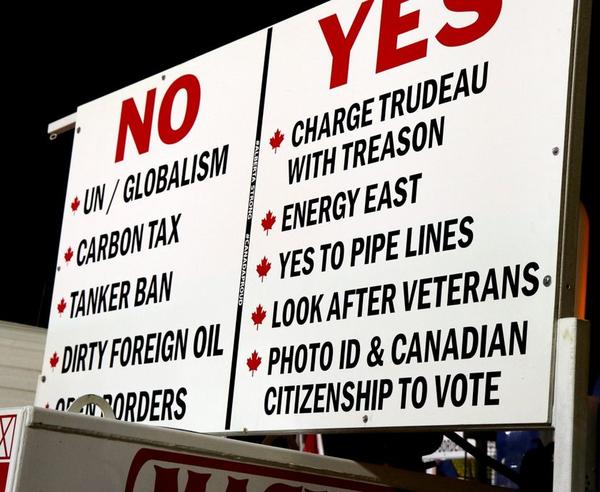
Prominent sign in the 'United We Roll' convoy
The Conservative Party of Canada has had three decades to develop a climate plan, but federal party leader Andrew Scheer has so far produced nothing other than categorical opposition to whatever the Liberal government comes up with, coupled with deliberate misinformation about how the carbon tax works.
Indeed, the near-universal conservative refusal to endorse their own conservative policy approach when actually implemented (by other parties) threatens to topple even the meagre first steps Canada is taking to tackle the greatest existential threat of the century.
Canada has been slumbering into this climate crisis for the past 30 years. Now, beset with heat waves and droughts, extraordinary wildfires, historic flooding, routine "once-in-a-century" storms and a warming rate twice as fast as the global average, we need to WAKE UP.
Here's a confidential aside to conservatives: if you value stability and consistency, you're going to really hate living in a world of climate chaos.
One way or another, things are going to change. We have a choice: we can manage the change that needs to happen, or we can keep playing dumb and the crisis will manage us.
One of the main objections to the carbon tax is that too many Canadians are living on the edge of financial ruin and can't afford to pay any more for transportation, heating and cooling, and so on.
Notwithstanding the fact that the carbon tax is revenue neutral and most Canadians will actually receive more in the dividend than they pay in the tax, there is real truth to the observation that Canadians are not doing great financially.
The fact is that our economy has not been serving Canadians well for a very long time. For the past three decades, successive Liberal and Conservative governments alike have gone further and further down the rabbit hole of neoliberalism, a political ideology that low corporate taxes and lax regulations will somehow be good for the economy as a whole.
In the 1980s, during the Reagan/Mulroney era, this "trickle-down" approach was derided as a fraud, but that has not stopped both major big business-oriented political parties from returning to the same well again and again in the decades since.
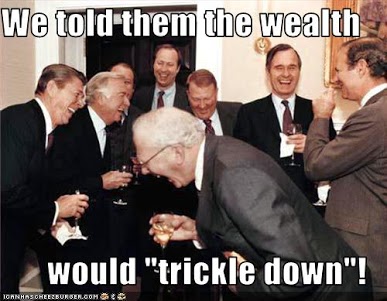
It's total bunk and always has been. When you give big corporations more money and power, they inevitably become richer and more powerful and the rest of us become poorer and less powerful.
Workers have less bargaining power to demand that they share in the wealth gained by productivity growth. Consumers have less buying power to demand products that are healthy, safe and sustainable. And citizens have less political power to ensure that the government serves our values and interests rather than corporate imperatives.
But the more money and power big businesses accrue, the more influence they are able to exert over both major parties. Whether it's the Liberal government writing a new federal law to allow corporations to avoid criminal prosecution after intense lobbying from SNC-Lavalin, or the Conservative leader holding a secret meeting with fossil fuel industry executives, big business inherently corrupts our politics by buying the laws that most benefit their own narrow interests.
Across Canada, federal and provincial governments have been steadily cutting corporate tax rates since the 1990s, and the predictable result has been the incremental starvation of public programs while corporate profits soar.
When you give bigger tax cuts to corporations that already have high profit margins and large stockpiles of cash, they just stockpile more cash. They indulge in share buybacks, give out fat dividends to shareholders, pay huge executive bonuses, and participate in ever more outlandishly complicated financial instruments designed to squeeze value out of the market, not insert value into it.
They certainly don't volunteer to pay their workers more money, or hire more people, or invest in human resources. And because the government keeps giving them bigger cuts, there is less and less money available to fund essential public services.
Despite relentless economizing on public spending, governments that are starved for revenue end up running deficits just to keep the lights on. Right-wing politicians then use those deficits as an excuse to justify further cuts in public spending, falsely claiming that spending is "out of control".
We saw this happen last year in Ontario, where the Ontario Progressive Conservative Party won a majority government on the blatant lie that the previous Liberal government was spending wildly. In fact, Ontario had the lowest per capita public revenues and the lowest per capita program spending in Canada under the Liberals.
As I wrote last June, Ontario has a revenue problem, not a spending problem. Last week I pulled the Provincial Fiscal References Table from Statistics Canada for fiscal year 2017-18 to update the numbers, and the situation remains the same.
On the public revenue side, Ontario is tied for last place with British Columbia for having the lowest per-capita revenue.
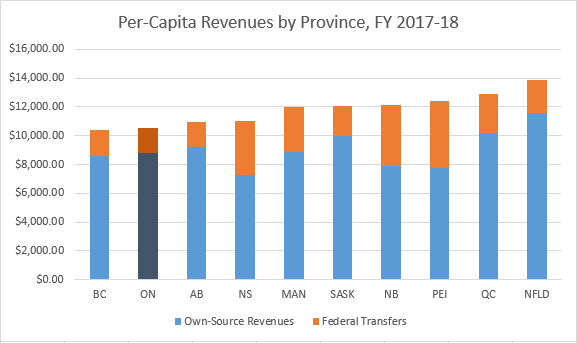
Chart: Provincial per-capita revenues, FY 2017-18
And because we don't have enough revenue, we are also tied for last place on per-capita program spending.
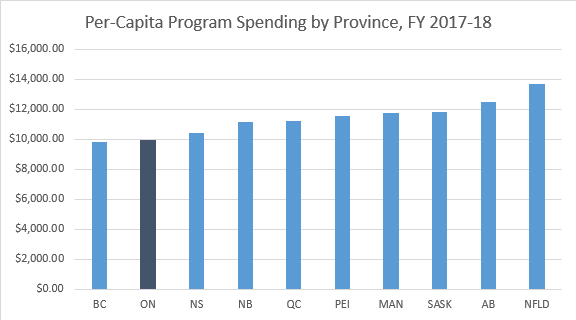
Chart: provincial per-capita program spending, FY 2017-18
And while the absolute size of Ontario's debt seems scary, it's important to remember that Ontario has big numbers because we're a big province, with close to half the entire population of Canada. When you look at our debt servicing charge per capita, we are in the middle of the pack.
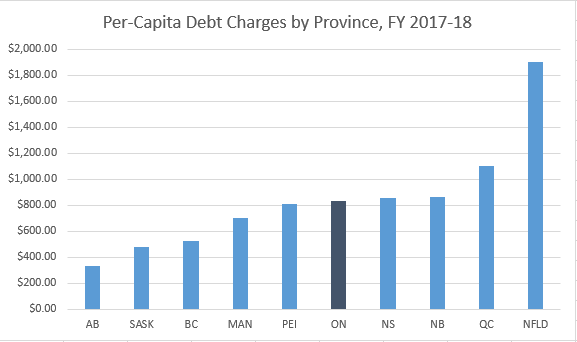
Chart: provincial per-capita debt service charge, FY 2017-18
Meanwhile, Ontario Premier Doug Ford is actually making our deficit and debt worse by further cutting corporate tax rates and using that as an excuse to further cut public spending.
So we are a nation in crisis and we find ourselves at a crossroads: after 30 years of neoliberalism, we have failed to reduce our GHG emissions and most people are desperate for some social and financial security.
On the environmental front, we are at risk of catastrophic global warming, while on the socioeconomic front the great middle class is being squeezed on all sides by flat incomes, rising costs and worsening social programs.
The good news is that this crisis presents an extraordinary opportunity.
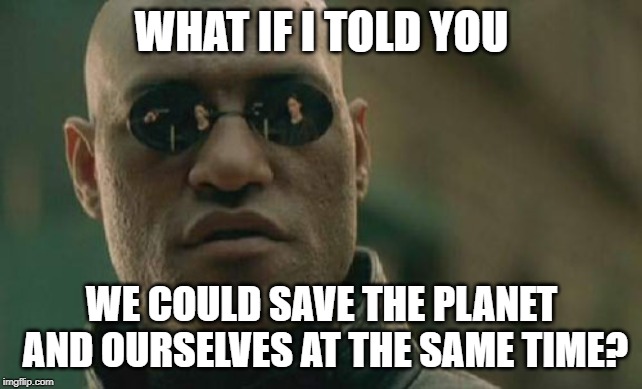
You may have heard about the idea of a "Green New Deal" lately. The term comes from our neighbours to the south and references Franklin D. Roosevelt's "New Deal", a massive expansion of public investment and policy in the 1930s to end the Great Depression and lift people from poverty.
The idea of a "Green New Deal" is to make a similar massive investment in public funds and policy changes to rapidly transition our economy off fossil fuels while again lifting people from poverty.
We know that a modest carbon tax won't be nearly enough to nudge our economy off fossil fuels. And notwithstanding the carbon dividend, it's not fair that consumers have to take responsibility for a carbon-intensive economy that was developed and maintained by a handful of industry players.
It's also unfair that workers who have committed their lives to jobs in the current carbon-intensive economy should be left behind in a transition to a green economy.
A Green New Deal is a way to satisfy all these constraints: a rapid transition to a sustainable economy that brings everyone along, delivering more prosperity to Canadians and guaranteeing that no workers will be left behind in the transition.
It will cost a lot of money, to be sure. The government will have to borrow in order to invest. But today, due to neoliberal tax cuts, the government is already borrowing just to keep the lights on, since big corporations and millionaires have successfully weaseled out of having to pay their share.
The environmental challenge is global warming. The political challenge is neoliberalism. The solution is a comprehensive, nation-wide, all-hands-on-deck commitment to transforming Canada into a country that is ready to survive the future.
Let's go back to that chart way up at the top of this article. I chose those comparator countries because they also provide a very high quality of life for their residents - higher, in many ways, than most Canadians enjoy.

Chart: Per-Capita GHG emissions (tonnes of CO2 equivalent) for Selected Countries, 1990-2013
What we know from those countries is that it is possible to decouple the economy from fossil fuels - to decarbonize without economic collapse.
And what we know from previous extended runs of economic prosperity - specifically, from the 1930s right through to the 1970s - is that when the wealth generated by a market economy is shared widely among everyone rather than concentrated among the very rich, economic growth is actually more robust since everyone can afford to live.
(This is why, after the January 2018 increase in Ontario's minimum wage, the economy continued to grow and unemployment continued to fall despite all the "sky is falling" doomsaying from conservatives and business interests.)
There is absolutely NO REASON - aside from the catastrophic risk of politics-as-usual - why we can't transition to a more just future. But we need a clear idea of where we need to go and what we need to do to get there, and we need a united, citizen-based movement that can communicate the risks and opportunities and mobilize support to restore government power from big business back to the citizenry.
That's a tall order, and we need to hurry - the best scientific evidence tells us that we have about a decade to dramatically change course if we want to avoid uncontrollable runaway global warming and an uninhabitable planet within this century.
Will we meet this existential challenge? Will history look back on this as the moment when we finally rose up and saved humanity? For the sake of our children and grandchildren, I certainly hope so.
By Crispy (registered) | Posted May 13, 2019 at 13:26:32
Ryan why can't I up or down vote a post?
By KevinLove (registered) | Posted May 16, 2019 at 22:52:10 in reply to Comment 126559
Perhaps because Ryan wishes you to adopt the unusual habit of thinking for yourself.
By Crispy (registered) | Posted May 17, 2019 at 05:09:59 in reply to Comment 126583
Perhaps you should let Ryan speak for himself.
Comment edited by Crispy on 2019-05-17 05:20:19
By ergopepsi (registered) | Posted May 14, 2019 at 13:14:55 in reply to Comment 126559
Probably because he knows some cretin will sit there clicking 'up' or 'down' 900 times to make a point of how sad their lives are.
You must be logged in to comment.
There are no upcoming events right now.
Why not post one?